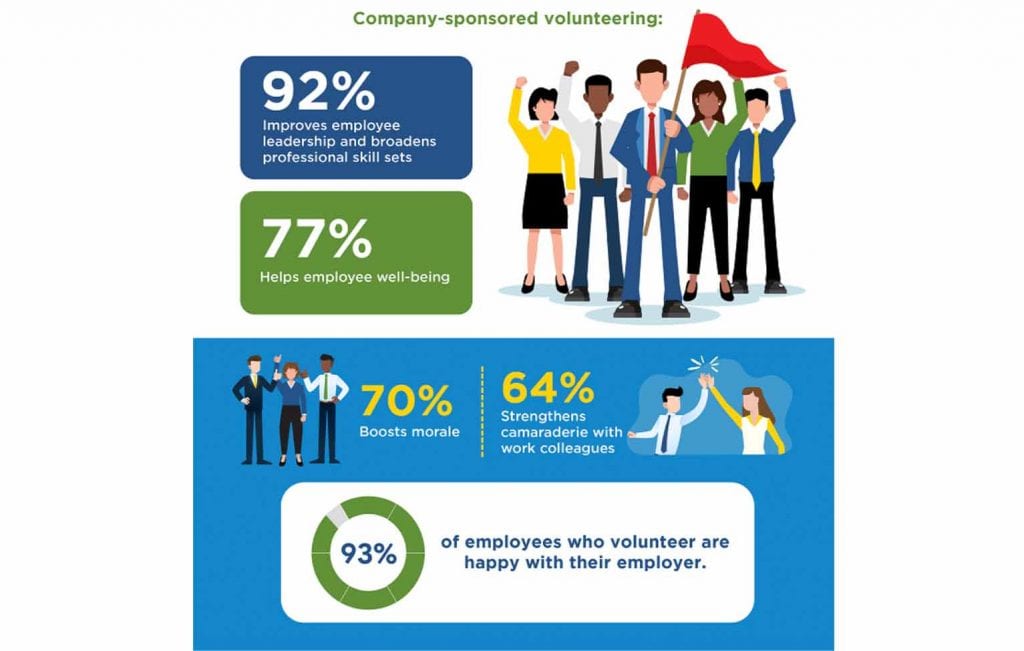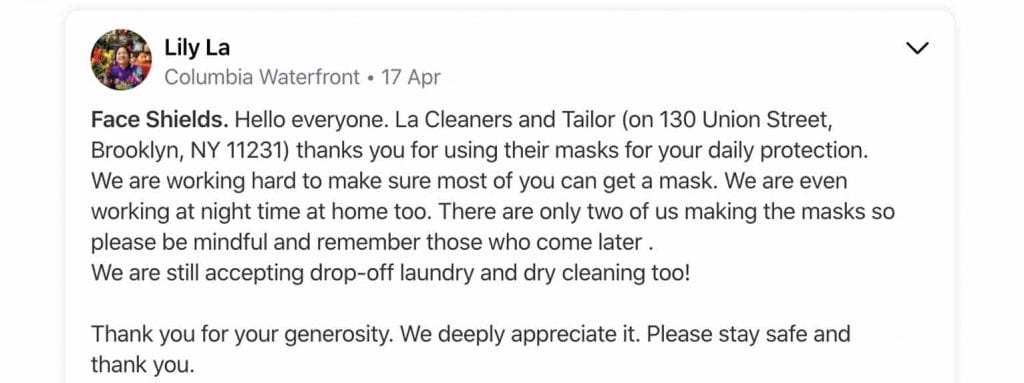During these challenging times, it’s easy to turn inward instead of engaging with our community. But that’s far from ideal, especially for small businesses.
Indeed, many local companies are stepping up to support their communities and they’re reaping the benefits of being part of the solution.
Find out how businesses are giving back to their communities and why doing so can benefit your business. We’ve spelled out 17 ways you can give back to your local community (without breaking the bank), along with inspiring examples on how local businesses are contributing to the greater good and some best practices you should follow.
How Small Businesses Are Supporting Their Communities
When compared with large corporations, small businesses are more likely to contribute to charitable causes and their donations make up a larger percentage of their profits.
SCORE found that small businesses donate 250% more than larger businesses to local community causes and about 75% of small businesses donate to charity. Also, they contribute an average of 6% of their profits to charitable causes, more than what large companies typically contribute.
What do small businesses give to?
According to SCORE, some 66% of small businesses donate to local charities, 48% support youth organizations, 42% of them aid first responders, 39% give to local religious organizations, 37% support local service groups (e.g., the Boy Scouts of America) and 32% donate food or volunteer in soup kitchens.
How Businesses Benefit From Giving Back to the Community
Giving back to the community offers many short- and long-term benefits to small businesses. Here’s why you should start or continue donating to your community even during this challenging time:
Enhance Your Reputation
According to a 2010 study by Cone Communications, 85% of consumers develop a positive impression toward a company that donates to charitable causes?
Participating in community philanthropy shows that your company is dedicated to the well being of those you serve. It also gives you the opportunity to share your company’s vision and values so you can bolster your reputation and enhance your brand image.
Raise Brand Awareness
Sponsoring or volunteering in local community events can give your brand a publicity boost and exposure to potential customers who may not know about your business.
Also, you can create content based on the event (e.g., photos, videos, a written recap) to share and drive traffic to your website.
Build Positive Relationships With Your Community
Small businesses thrive on community involvement and supporting a cause that your customers care about can help you stay top of mind. Giving back also reinforces your relationship with the local community, which sets you apart from larger corporations.
In addition, being involved in community initiatives gives you a chance to connect with customers on a personal level. For example, 81% of millennials expect companies to commit to corporate social responsibilities, according to Forbes. They’re attracted to companies that make giving back part of their brand identity and willing to pay more to buy from brands that embody their values.
Attract and Retain More Customers
Helping your local community sets your business apart from your competitors. People like to support local businesses and want to know that the money they spend is benefiting their community.
Being involved with your community also helps you build a brand that resonates with consumers who share your values. This reinforces loyalty and helps you attract and retain more customers.
Improve Employee Engagement
Participating in community philanthropy helps engage your employees, build a positive company culture and increase employee satisfaction, which can help attract and retain talents. Indeed, HubSpot found that 93% of employees who take part in company-sponsored charitable causes are happy with their employers and a PwC study found that engaged employees are 87% less likely to resign.
Other key benefits of employees giving back to the community include:
- Improve leadership capabilities and broaden professional skill sets.
- Enhance physical and mental wellbeing.
- Improve morale and team collaboration.
- Strengthen camaraderie among co-workers.

Change Our Collective Future
Business volunteering has taken on new meanings since the pandemic. It’s no longer just a “feel good” thing that you do when it’s convenient. We need to make deliberate decisions, despite challenging circumstances, that will bring people together to create meaningful impacts in our collective future.
When you make intentional choices, your brand will be known for not only what you donate and the immediate results, but the empathy of your actions, which will have a ripple effect that others will remember in the long run.
17 Ways Businesses Can Give Back to Local Communities
Giving back sounds all well and good, but during this challenging time it may not be easy to come up with extra cash. Here’s how you can give back without breaking the bank:
- Donate, collect and deliver necessities and supplies such as nonperishable food items or clothing to food pantries and shelters.
- Help vulnerable populations (e.g., the elderly and those with health conditions) with grocery shopping or meal delivery.
- Support local restaurants by buying meals from them and then delivering the food to health-care workers in clinics and hospitals.
- Offer pro bono services for people in need.
- Mentor or teach new job skills to those seeking career advice or looking for new jobs. Using telephone or video conferencing technologies, you can even reach more than one person at a time so more people can benefit.
- Share your knowledge by teaching an online class offered by a local community center.
- Buy from neighboring small businesses, post online reviews and share their links to support each other.
- Help local charities launch fundraising initiatives. In particular, many of these organizations lack the resources to coordinate online events.
- Put a donation jar at checkout or give customers the option of adding a donation to their credit cards (e.g., rounding up to the nearest dollar.)
- Incorporate a “give back” component into your referral program and let your clients know that you’ll donate to a charity when they recommend others to your business.
- Participate in a letter campaign (e.g., Cardz For Kidz delivers homemade cards for hospitalized or traumatized children), which is particularly timely because employees can contribute remotely.
- Offer a company match when employees donate to a qualifying charitable organization or volunteer their time.
- Carve out a day during which everyone in the company participates in volunteering activities. While large group events may not be feasible now, you can use this as an opportunity to start a tradition that lasts.
- Redirect your resources to produce items needed by the community at this critical time. For example, a tailor can make cloth face masks and businesses with 3D printers can produce parts for medical devices.
- Donate a portion of your revenue in a set period or on the sale of a specific product to a charity.
- Support a local community event, for example, by volunteering at a 5k race or donating products or service packages for a silent auction.
- Support your employees and their families by helping them cope with this challenging time. You can offer flexible remote work schedules, child-care assistance and paid sick leave.
Examples of Businesses Giving Back to the Communities
Looking for inspiration on how you can support your community? Here are some examples of businesses that are giving back:
TwentyTables Delivers Meals to Health-Care Workers
TwentyTables connects food vendors to consumers and food-insecure organizations by donating a meal to charity for each one it serves. The company realized that it could do more during the COVID-19 pandemic to show their support to the community.

The company redirected its resources and coordinated its network of vendors to serve thousands of meals to health-care workers through the “Feed the Frontline” campaign. For every $700 raised, it sent a food truck to local hospitals with 100 meals for those working at the frontline of the COVID-19 crisis.
In a couple of months, TwentyTables has raised more than $30,000 and served meals to health-care workers at 10 hospitals in the Washington, D.C., area. Meanwhile, it helped its vendors, a network of 100-plus local businesses, continue to generate revenue and provide employment during the lockdown.
Steele Canvas Pivoted to Manufacturing Masks
Steele Canvas Basket, a century-old, family-owned Massachusetts company, has built a thriving business manufacturing canvas and steel storage carts. When the pandemic hit, it pivoted to making masks to meet the needs of the local market.
Not only is the company helping the community stay safe by alleviating the mask shortage but it also avoided laying off its employees. In fact, it has contributed to the community by hiring additional staff during this difficult time.
Steele Canvas Basket isn’t the only business that stepped up and pivoted to help its community ride out the pandemic. Companies have repurposed manufacturing lines to sew or 3D print masks. Etsy entrepreneurs turned from sewing bags and linens to full-time mask production. Meanwhile, tailors are producing masks and giving them to the local community.

Great Harvest Bakery Cafe Owners Donate Food
During the COVID-19 crisis, an army of nearly 200 Great Harvest franchise owners joined forces to set up donation shelves, offer free food to families in need, supply food banks and make their daily-milled wheat and fresh ingredients available to their communities.
Some franchise owners teamed up with other small businesses to set up free farmer markets while others prepare box lunches for health-care staff and other essential workers. Their efforts have obviously resonated with the communities, as many received support and donations from their customers so they can continue helping those in need.
Best Practices for Local Businesses Helping Communities
Unlike large corporations, small businesses have limited resources so it’s important to be intentional about how you contribute to charitable causes. Here’s how you can make a bigger impact:
Look for the Right Fit
There’s no lack of charitable organizations, but how does one go about choosing the right one?
You should select a cause that’s meaningful to your company and resonates with your employees because people are more likely to get involved when they feel connected to the cause. The mission of the charity should align with your company’s values, as well as the products or services that you offer.
Also, consider how your existing network and infrastructure, such as procurement processes and vendor relationships, can help a charitable cause. For example, TwentyTables leveraged its vendor relationships to create a win-win situation.
Do Your Research
While there are many well-known charities, not all of them are well-run. If you give to a charity that doesn’t allocate its resources effectively, your money and efforts could be wasted.
Research the organizations that you’d like to support using online resources such as Guidestar, Charity Navigator and the Better Business Bureau Wise Giving Alliance. Also, don’t hesitate to contact the executive director of these non-profit organizations to see if they’re set up to effectively utilize the resources you’re planning to donate.
Develop an Ongoing Relationship
Contributing to your community shouldn’t be just a year-end activity that you check off the list. When you find the right cause and the right charity, establish an on-going relationship with the organization and see how you can be involved year-round. For example, you can volunteer, sponsor events and donate your products throughout the year.
An on-going relationship is often more productive because you can focus on contributing instead of ironing out the logistics. It’s also more likely that you can establish a win-win situation, such as having the charity publicize your support during their events or in their donor newsletters.
Rally Your Employees
When employees take part in shaping your give-back initiatives, they’d more likely be actively involved in the long-term. Ask them to identify causes to support and select the charity to give to. This also shows that you value their input, which can boost morale and loyalty.
Anticipate challenges because some employees may not want to get involved or don’t agree with the cause. Stay your course but remain flexible (e.g., allowing employees to opt-out of the activities.) You also can encourage employees to volunteer and make their own contributions to a cause that’s meaningful to them by implementing a matching gifts program.
Be Transparent
About 90% of consumers want to know how companies support charitable causes, according to SCORE. In particular, if your initiative involves donating part of the profits to a charity, your customers will want to know that their money is going to the right place and helping the right people.
You can communicate your give-back efforts in your newsletter, social media pages and blog to keep your followers in the loop and let them know how you’re contributing to the community.
Seek Professional Help With Tax Deductions
While charitable donations offer some tax benefits, keep in mind that these contributions only qualify under certain conditions. It’s best to consult a financial or accounting professional to make sure that you’re contributing to eligible charities and deducting Internal Revenue Service-sanctioned donations or expenses.
Ask for a written statement from the organizations to which you contribute and keep records of all the donations for 7 years in the event of an audit.
Supporting Your Community Is More Important Than Ever
You don’t have to be a large corporation with a big budget to make a difference. Businesses of any size can help their local communities by donating time, money, resources, knowledge, elbow grease, and more.
Giving back to your community is particularly important during this challenging time. Besides making an impact in your community, you get the chance to foster relationships with customers, employees and partners — benefiting your business for years to come.
There are many ways to give back to your community. Get inspiration from other local businesses that are making a difference. Be creative and offer relevant solutions that can bring the most value to those in need.
To reap the many short-term and long-term benefits of contributing to charitable causes, follow the best practices suggested in this article to make sure that you’re helping a meaningful cause, optimizing your resources and building lasting relationships.











